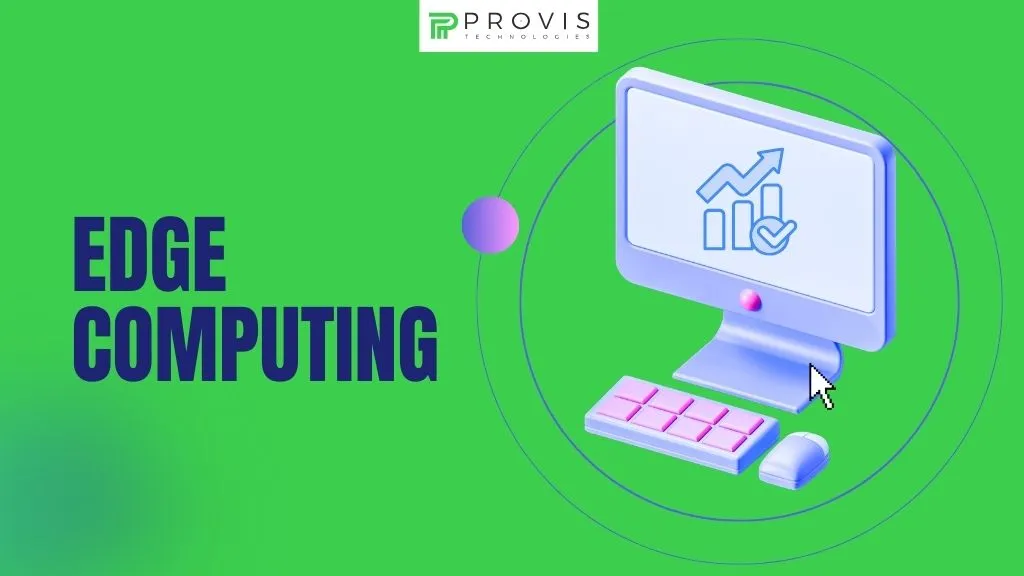Edge computing is an example of new-age technology revolutionizing how data is processed in a digitally connected ecosystem. But why edge computing is so important? Because it brings processing power closer to the data and doesn’t send the data to a centralized location to be processed. As the internet keeps on connecting the world, a huge amount of data is generated every day. Edge computing plays a significant role in processing those data and shaping the future of technology.
As internet connections among various types of digital devices are growing, ensuring faster loading of webpages, buffer-free video calls, and real-time streaming videos are getting important. Edge computing benefits by making sure that you get all of these facilities whenever you need them.
In this blog, we will learn what is edge computing, the impact and drawbacks of it on web development, and what the future looks like.
Let’s get started!
What Is Edge Computing?
The data that are generated online are processed in different centralized data centers. So, the data needs to travel from the device where it was generated to the data center, which can be miles away sometimes. Though we have some cutting-edge technologies, such as modern servers and networks, to take the data to the center, it still causes delays sometimes.
To save the data from this delay, edge computing comes into play. This computing processes the data close to the place where it is generated. This means the data is processed at the edge of the network and not at the data centers. This facility reduces the distance the data has to travel and speeds up the processing.
Edge computing uses various devices such as servers, smartphones, and routers to process the data. This close processing of data can be beneficial for many businesses and their customers.
Impact Of Edge Computing On Web Development
Now, let us explore how edge computing for website performance works and how you are getting benefitted from it while browsing the internet.
Website runs faster
While opening some websites it might take longer than usual for them to open. This is where edge computing comes in handy. As edge computing processes the data in a local server, it helps the websites load on your device faster. So, for whatever reason you might need to access any website, you can do it faster than ever.
With the aid of edge computing, web developers also don’t need to rely on distant servers to process the data. This allows them to handle the website traffic most efficiently. It improves the website performance optimization and also provides a good user experience.
More reliability
With traditional web hosting, any website can go down very easily, which might cause huge problems for the customers using that website. However, edge computing can save web developers from this crisis as well. Edge computing provides distributed computing for websites and sends the data across many edge servers, so when one server goes down, the other servers will take over and keep the service intact.
This way edge computing provides a more reliable service while you are doing any important tasks through any website. It makes the websites more user-friendly and trustworthy to the customers.
Provides good security
Security is very important in today’s digital world. However, in traditional computing processes, data travels from devices to a centralized data center through various servers, which increases the risk of hacking. However, with edge computing, this problem never arises as the data is processed locally.
Edge computing for security in web development also helps in complying with data privacy laws. As it processes and stores data locally, it adheres to the specific laws of that region, which is beneficial for global services. This means the data of the customer is protected according to the highest legal standards.
Personalized user experience
Edge computing can also provide customers with a personalized user experience by analyzing user data in real-time. It helps the website to tailor content according to your need. With the help of edge computing, web developers can design more engaging websites according to their user preferences to increase user engagement. It also helps in website speed optimization, so that the customers get better service.
So, the next time you do online shopping and see products that are relevant to you, edge computing is behind it. Web developers can stay ahead of their competitors by adopting edge computing.
Drawbacks Of Edge Computing In Web Development
Now, let’s understand what are the challenges or drawbacks of edge computing in web development.
Complex implementation process
Implementing edge computing in web development is a very complex process as it requires various networks of servers and the proper infrastructure to handle data efficiently. Setting up edge computing requires maintaining a lot of servers and a lot of technical resources. Each of these servers needs to be configured properly, which can be challenging sometimes.
Also, managing network traffic in all these servers so that the data can flow without any hazard is very important. If the data can’t flow smoothly, then there will be data loss. So, managing network traffic also involves complex processes that are hard to implement.
Security risks
As edge computing processes data locally, it enhances the security of the data. However, localizing the data processing can also introduce attack surfaces. The more servers that are there, the more chances there will be for data breaches. Web developers need to ensure all the local servers comply with regional data protection regulations, which is not very easy to do.
Web developers can apply uniform security measures for all servers, but that also requires constant vigilance to keep the process smooth.
Different scalability issues
In web development, edge computing is meant to scale depending on demand, but as there will be multiple edge locations, the web developers need to scale out multiple infrastructures for all those different edge locations. This process can be very expensive. Even the initial set-up cost and maintenance will be very high.
Even in the case of dynamic scaling, adjusting the resources to meet various data loads can be very complex as well as it requires advanced automation tools. This process is even more complex when the services are separated by geographically dispersed areas.
Technical skills
To implement edge computing in web development, the developers need to have a broad range of technical skills. They need to know everything about cloud computing, network, and security management. Edge computing is such a field where development keeps happening, so, the developers need to keep up with all those developments and keep learning about new tools and approaches to keep them updated.
These are a few challenges that web developer needs to keep in mind when implementing edge computing in their websites.
The Future Of Edge Computing On Web Development
Now, let’s discuss what the future of edge computing in the field of web development looks like.
Integration with IoT devices
The Internet of Things, or IoT is expanding, and edge computing will play a critical role in this expansion. IoT devices such as smart home appliances and wearable health monitors generate a vast amount of data. So, if this data is processed where it is generated it will able to provide faster responses to the users. In cloud vs edge computing, edge computing helps provide services better with IoT devices.
Provides real-time analytics
In the future edge computing will increase the abilities of AI to process data in real-time. With the help of this computing, the AI applications will be able to process complex computation locally which will eventually make data processing quicker and efficient.
Environment-friendly technologies
Edge computing in web development will also help in producing greener technologies. Edge computing reduces the need to send data to a centralized data center and, with it reduces the need for overall energy consumption of the network. Local processing of the data can also lead to more efficient processing of data with less power consumption.
Good mobile experience
As the usage of mobile devices is increasing, edge computing can play a great part in web development on mobile devices. Mobile devices suffer from slower internet connection and edge computing helps in solving these issues by processing data locally. It will help in enhancing the mobile services.
Conclusion
Edge computing helps in enhancing the performance of web development by processing data locally. It also provides reliability and security and offers a personalized experience to the user. It also helps in implementing AI in the system and processing data in real-time. Web developers should adopt the implementation of edge computing to provide their users with a more reliable, reduced website latency with edge computing and engaging web experience. Edge computing not only makes data processing swifter but also creates a dynamic environment for the user.
FAQs
What is edge computing?
Edge computing is a networking technology that processes and stores data closer to the devices where it is produced. This computing allows faster data processing and provides real-time insights. It reduces bandwidth usage and also improves the performance of the application or website.
How does edge computing affect the security of any website?
As edge computing processes data locally, it initially increases the security of the data as the data doesn’t have to travel to the centralized data center. However as computing needs various servers and networks to process the data locally, it increases the chances of attack surfaces.
Can we use edge computing for all types of websites?
Dynamic websites benefit more from edge computing as it requires quick data processing. Static websites might not get much benefit from edge computing as it doesn’t contain much interactive content.
Written By
Author's Picks
- Best Web Development Tools For 2023
- 08/07/2023
- Top 5 Color Palette Generators for Website Colors
- 20/06/2024
- How to Design an Effective UX Design Strategy
- 04/07/2023
Categories
- AI for Startups
- AI in Web Development
- AI Integration
- AI Platforms
- AI Prompt
- AI Tools
- AI Trading Software
- Android App
- Android vs iOS Development
- Angular
- API
- API Development
- App
- app development
- App Idea
- App User Feedback
- Application
- Artificial Intelligence
- Audit Services
- Automotive Industry
- Awards and Recognition
- Business Consulting
- Business Website
- Chatbots
- CRM
- CRM for Financial Advisors
- Custom CRM
- Custom SaaS
- Custom Website
- Customer Service
- dashboard design
- Developing a Mobile App
- Digital Business
- E-commerce
- EMR Integration
- Finance
- Financial Advisors
- Financial Advisors
- GIT
- Health Insurance
- iOS App
- iOS App Development
- IoT Mobile App Development
- IoT Platforms
- IT Audit Services
- IT Consulting
- IT Strategies
- Java Development
- Laravel
- Lean Canvas
- Learning Management System
- Logistics Apps
- Mobile App Development
- MVP
- Native App
- News Aggregator Site
- OTT
- Outsourcing IT
- Payment Gateway
- predictive analysis
- Product Launch Strategy
- Progressive Web App (PWA)
- Prototype
- Recommender Systems
- Ruby
- SaaS
- SaaS Application
- SaaS Business
- SaaS Company
- SaaS Development
- SaaS Product
- SaaS Project
- Sales Funnel
- SEO
- Shopping Cart
- Software Development
- SSL and TLS
- Startup Checklist
- Technology
- Tetradic Color Scheme
- UI/UX Design Company
- Unit Testing
- User Flow
- User Testing
- Web Development
- Web Performance Optimization
- website Maintenance Services
- Website Migration Service
- Website Speed Optimization
- WooCommerce
- WordPress





